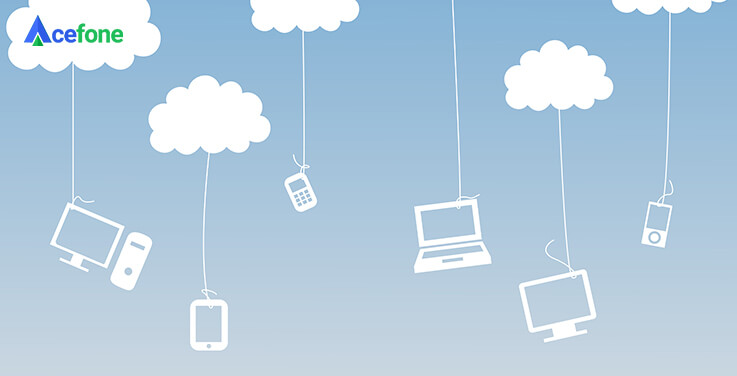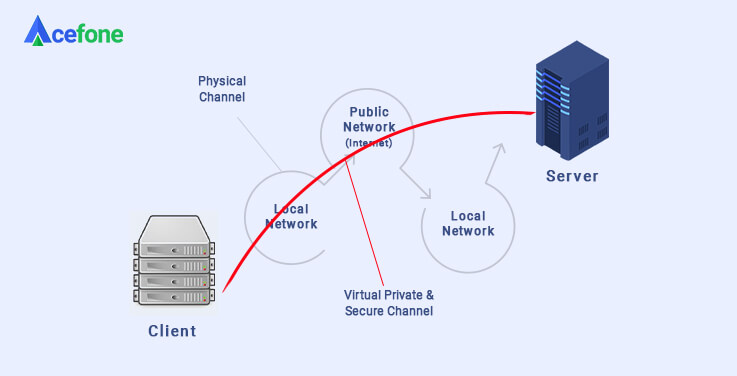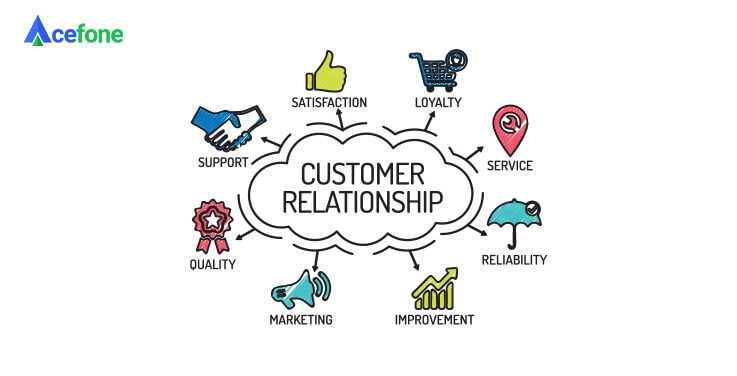
Do you recognise all these languages? You may or may not be well-versed in them, but your clients probably are. The whole world has become one giant marketplace with customers literally everywhere on the globe.
In this scenario, would you be willing to incur massive costs for communicating with your international clientele? Wired telephony ties you down, and charges you exorbitant amounts for that!
So what now?
Fly higher than your competition using cloud phone systems instead; a one-stop solution for all your business communications hosted over cyberspace!
Here’s everything you need to know about hosted phone systems to get started on your journey.
→ Chapter 1: Introduction to cloud phone systems
→ Chapter 2: Emergence of the cloud
→ Chapter 3: Do you need the cloud?
→ Chapter 4: Features to look for
→ Chapter 5: Benefits that help you thrive
→ Chapter 6: Integrate your way to success
→ Chapter 7: VoIP regulations to consider
Chapter 1: Introduction to Cloud Phone Systems
Eat or be eaten.
Charles Darwin had famously theorised the survival of the fittest. While he painted quite a gory picture, the crux of the matter is that you need to constantly keep evolving with changing times. Did you know that birds are essentially dinosaurs?
65 million years ago, when the dinosaur extinction happened, some survived because they shrunk into birds. Their beaks could now crack open nuts and seeds buried in the topsoil.
What I’m trying to say is: don’t stay a dinosaur, become a bird.
Your established traditional telephony system might be a source of comfort, but sticking to it might weigh you down. Instead, switch to the cloud. You can avail amazing benefits that help streamline your business communications and increase efficiency. No wonder 76% of small businesses and entrepreneurs are adopting cloud solutions these days.
You may come across different terms like Voice over Internet Protocol (VoIP) calling or Internet calling. Don’t be confused; these are synonymous with cloud-based phone systems. With this system in place, you can hold calls over the Web and use a variety of devices to do so—traditional phones, smartphones, softphones, and VoIP-enabled phones.
Rather than maintaining the data on-premise, the cloud hosts all the information on a secure server. On-premise systems take up a lot of space and require regular and expensive upkeep. With online phone systems, not only do you save on high installation costs, but you also incur minimal maintenance and updating costs. Your service provider will take care of it all.
So how does a VoIP Phone System work?

Let’s put it down simply. Calling over the internet follows a standard procedure: first, your voice gets broken into smaller digital packets and is sent as data to the recipient. Generally, the call is then routed using a cloud-based private branch exchange (PBX).
This streamlined process allows for seamless communication with anyone possessing a web connection. You can use different devices for this in the following way:
1. Traditional phone systems: You can attach a VoIP adapter to your wired telephone to host Internet calls. This adapter can be plugged into the wall or your router.
2. Smartphones: You can simply download apps onto your mobile device for efficient communication.
3. Softphones: This refers to calling using computers. Various software and apps can be used for calling. So when you accept a FaceTime call on your Mac, you’re basically using your computer as a softphone.
4. VoIP-enabled phones: These are similar to traditional phones. But while analogue phones are on a phone line, VoIP phones are connected to a computer network. Basically, you can convert your analogue system into a Web-based one easily, which makes switching to the cloud a feasible option at all times.
Setting up
Installing an internet-based phone system is super easy. Since there is no bulky hardware to set up, the process is quick, efficient, and most importantly, extremely cost-effective.
You save on precious time as well. In fact, you can switch to a VoIP system in a matter of minutes.
Imagine this: you decide to adopt cloud communications at the start of the day. All you need to do is contact a skilled service provider, discuss and design a plan that suits your needs and get it installed. And all this before lunch hour! Spend a few hours training your staff about the system and their workflow—and by the end of the day, you’ll have a wholly transformed business.
Using a call flow
While it’s true that you get a myriad of benefits with the cloud, you need to be able to make the best of its offerings to avail optimal results.
Call flow refers to the management of how your calls are routed. This becomes especially important when you’re using your cell for both business and personal communications. This flow can be tailored to your preferences, but basically you can set how and when you receive calls, decide where the call will be routed to, and even choose to see the location of the caller.
There’s so much scope to enhance customer engagement with these features. Use it wisely, and watch your business blossom.
Chapter 2: Emergence of the Cloud
Contrary to popular belief, the cloud is not the new kid on the block. In fact, it’s got quite a few years on it (think the 1960s). Over the decades, it has slowly crept up to the telecom industry and massively transformed itself.
A man is simply a sum of his life choices. Similarly, the cloud is what it is today because of its past. If you’re not a history buff, don’t worry, we’ll go through this very briefly.
In the 1950s, the cloud emerged with the onset of mainframe computing. In this system, multiple users were able to use the capabilities of a single central computer through several terminals. This was widely accepted because of its cost-saving features and resource sharing. It was in the 1960s that the idea of an ‘intergalactic computer network’ was introduced by J.C.R. Licklider.
Then we reach the 1970s. Disco was not the only emergence of this era—virtualisation also began. This concept took mainframes to the next level, as several virtual computers could now be linked to one physical resource.
The launch of Integrated Services Digital Network (ISDN) in 1988 allowed transmission of both voice and data simultaneously through copper wires. This greatly improved the scope of telecommunications in the following years.
90s kids will tell you that these were elite times. They’re not wrong. Cloud computing, too, took a leap in the 1990s. You must have heard of VPNs; they’re still widely used. Well, virtualised private networks came into being around this time.

Earlier, telecommunication companies had to offer services on a point-to-point basis. With VPN, the same quality of data service was now available at a fraction of the cost. Further through the years, the cloud has simply been enhancing. Software as a Service (SaaS) slowly became the norm as the IT industry boomed.
Lastly, the 2000s. The modern era. After going through all its stages—infancy, adolescence, early adulthood—the cloud is a wise adult, constantly improving itself. Here we witnessed the birth of giants like Amazon and Google.
The cloud reinvented itself time and again, and it has become an indispensable form of communication. Data transferred virtually has enabled HD voice and video transmission, and made the process instantaneous.
Of course, the journey to becoming a massive technology was not without hiccups. Through multiple trials and tribulations, we now have VoIP technology: with a multitude of services and huge potential to boost all kinds of communications.
You can read about the emergence, importance, and future of the cloud in detail in this paper about cloud computing, published in IJSER.
Chapter 3: Do you need the Cloud?
Short answer: YES.
Long answer: Before entering the maze of features you can avail with the hosted phones, let’s address a more primal concern: how do you know when it’s time to switch to the cloud?
Honestly, it’s been time for quite a while now. Nevertheless, there are some signs that indicate it’s time to move to internet-based communications:
- You have increasing concerns about the security of sensitive data.
Business communications involve confidential trade information. In this extremely competitive landscape, it is essential to have a secure and reliable communication channel.
- You’re burdened by network issues hampering communications.
Your best clients could be located in an isolated area—with no phone towers in the vicinity. Moving communications to the internet ensures that the wide reach of wireless technology can ensure high-quality calls.
- You’re looking to expand your business.
While expanding is a hoot, its lengthy process in a traditional set-up is decidedly not. Rather than suffering through the arduous upscaling of your wired network or with expensive hardware installation, opt for a cloud set-up. It’s easy, it’s fast, and it’s unbelievably scalable. So you can continue your growth without qualms, and update your system timely and conveniently.
- You feel you’re not meeting client expectations, and possibly losing customers.
This is every business’s worst nightmare. Acquiring customers is hard enough, but retaining them is an even bigger challenge. If your firm is lacking in technology and the associated holistic assistance, customers might consider switching to a competitor who does offer them a more user-friendly experience.
- High consumer traffic is getting hard to handle.
If you’re starting to miss calls and are hurrying through customers in the face of a booming business, that’s a definite red flag. Ditch the wires chaining you down straight away. The cloud offers several features to help handle and streamline large flows of calls.
Chapter 4: Features to look for
We’ve seen how the limitations of a traditional phone system can hamper business growth, so now let’s learn how to turn that frown upside down. Yes, it’s finally time to explore what features you can (and should) expect in your cloud phone system.
Use this checklist to ensure that your provider serves you with the best-in-class features in the industry:
#1 Unified communications
Undoubtedly, this is one of the greatest and most widely used services in the IT communications industry. The mere simplicity of having all your correspondence on a unified platform aids in its popularity. Voice. Video. Messaging. All-in-one. It almost sounds like a mantra, no?
Your agents save on valuable time and are able to hold better conversations. In fact, the focus here is not just on communication. UC essentially promotes collaboration, which greatly improves productivity and leads to optimisation of business operations.
You can do so much more than just talk—send and receive files, share screens, sync calendars and integrate with other apps.
#2 Multi-level IVR
“Thank you for calling Acefone, your call is very important to us. Please hold while we connect you to a suitable agent. Press 1 for product queries, press 2 for refund policies…”
This was a classic example of an IVR greeting. A virtual receptionist can handle all basic queries and route the specific ones to a sales or customer service rep.
How smart your IVR is can be the x-factor that makes or breaks your business. Navigable key input menus are a common feature of this service. But instead of making the menus long and boring, you can just add multiple layers of menus to streamline the calls.
Additionally, intelligent routing can be used to direct the calls to the best-suited agent, in terms of skill, availability or even continuity of previous interactions.
#3 Free phone numbers
You cannot talk about cloud telephony without considering free number services. If everything else can be virtual, why not switch to virtual numbers as well? Apart from being easy on your pockets, these numbers are actually free for the customers to dial. That’s an amazing incentive to promote inbound calls.
Toll free number as the name suggests, are toll free for the callers while the company bears the minimal charges. They’re also called non-geographic numbers because they can be used anywhere in the country without local restrictions.
Furthermore, they usually start with a highly recognisable 0800 or 0808 pattern, which helps build credibility and improves your brand reputation.
You can even opt for vanity numbers to improve your contact’s recall value. Let’s take an example: 0800-PET-SHOP is very easy to remember, while also reinforcing your brand’s name in the caller’s minds. It simply translates into the corresponding numbers on the keypad. In this case, your actual number to be dialled is 0800-738-7467.
#4 Number portability
Now you may be thinking: all my customers know my established number, so I don’t want to change it and potentially lose connections.
You won’t. Number portability has you covered. Simply integrate cloud services with your existing number to enjoy all the benefits while also retaining your customers. You clients will be none the wiser; all they’ll know is that your services drastically improved. A happy customer means a happy business!
#5 Call recording and monitoring
They say you can never take back words. That’s certainly true, but the human mind does tend to forget words very often. With call recording features, you need not worry about losing any information. Easy access to the recording allows better call analysis and customer service, while also helping out in times of disputes.
Live monitoring also aids communication. You just recruited new agents? No need to worry about their slip-ups that might cost you customers. Managers have the option to whisper or barge in on calls if the need arises.
#6 Find me/Follow me
Your hosted phone system can be more loyal than your faithful dog. Give one command, ‘follow me’, and it will do so till the time you ask it to stop.
Find me/follow me is a technology that allows you to receive calls no matter where you are. Not only does it route calls to different locations, but it also calls whatever device you’re using at the time. You can assign the system to call multiple devices—parallel ringing—so anyone free is able to answer.
Sequential ringing is truly a ‘find me’ feature. This means that for certain urgent calls, your devices will sequentially ring till picked up. So first your office phone can ring, then your office mobile, followed by your personal cell, and finally, even your home phone. This ensures that you never miss an important call.
#7 User-friendly admin portal
An intuitive dashboard is a one-stop solution for all your communication needs. You can receive real-time updates on the progress of your agents, and guide them better for increased efficiency.
You can even track the progress of larger projects and maintain collaborative efforts. Analytics allow you to gain useful insights about customer preferences which can be used to modify future campaigns.
A picture is worth a thousand words. Graphic reports help visualise data better and ultimately give you complete insights about your operations.
#8 AI features
Artificial intelligence has significantly advanced over the years. You can now use AI to make your life so much easier. For example, speech-to-text features can do all your typing work for you quickly and accurately.
As we discussed before, AI can be programmed to forward calls to the right recipients every single time. There’s no need to waste time on manually looking for free agents to route customer calls.
Another amazing feature you need to look for is voicemail-to-email. Any call received after work hours can instead be converted into a voicemail, and instantly have it sent to your inbox so that you always stay notified. In fact, AI can also automatically create a transcript of the recording for you to look over anytime.
#9 Music on hold
Finally, it’s time to talk about music. If you’re feeling down, just listen to a happy song. If you’re bored, entertain yourself with some song and dance. If you’re travelling, create a vibe with your playlist.
So why not use the magic of music to increase customers’ experience with your brand? Practically speaking, there are times when you simply cannot avoid putting people on hold.
While your customer is waiting, play some music for them instead of an annoying beeping tone, the agent will finally face a happier client and increase the chances of retaining customers.
As you can see, there are plenty of features of a VoIP phone system that you can use to boost your business. You may even think of the cloud as a cornucopia, with features flowing out in abundance.
Chapter 5: Benefits that Help you Thrive
Hey, that rhymed! Speaking of rhymes and children’s fiction, who can ever forget the famous fairytale: Jack and the Beanstalk?
Jack plants magical seeds that grow into a huge beanstalk. When he climbs it, he finds the giant’s den filled with enchanted goods. Tone this tale down a bit (a lot actually), and you can find similar parallels in adopting a cloud phone system for your business.
A simple investment in an internet-based telephony system can cause unprecedented growth and optimal results for your business. The customer is king in this tale, and a VoIP service allows you to impress and secure clients with its multitude of benefits.

With an internet phone system, your efficiency and reliability increase, and you can improve the quality of your interactions. Therefore, you’re able to increase the overall service experience for customers. A happy customer is a repeat customer.
Let’s explore some of the many benefits you’ll be sure to enjoy with a VoIP phone:
#1 Lower cost, higher returns
Isn’t this ideal? You pay less for so much more. There is no expensive hardware or extra costs for set-up. In fact, you can enable VoIP service on your existing business phones to enjoy uninterrupted workflow.
Timely automatic updates are done like on any other software, which means you can enjoy an up-to-date system at all times without any additional expenses.
Put your haggling skills to rest. The best service providers in the industry provide bespoke cloud solutions. This means that you can tailor a plan specific to your needs and only pay for the features and number of lines you want to use.
#2 Feature-rich solutions
I know we mentioned features earlier. But their variety and scope deserve an encore. These features provide extreme flexibility to businesses, especially in non-traditional work environments these days.
There’s no denying that flexibility is of the utmost importance for a budding business.
Picture This: Due to some personal issues, your best employee is suddenly tasked with taking care of their kids alone. This means they need to drop and pick the kids from school, have supper prepared, and take out some quality time to spend with the little ones. At this point, if you can offer your employee flexible working hours and the ability to work on the go, you won’t suffer the loss of agent output. At the same time, the quality of work will improve when the employee can focus their attention on work without worrying about personal matters.
A work-life balance is essential for staff satisfaction and to prevent burnout.
Similarly, if you’re looking to expand your operations and wish to deploy international centers, cloud phone systems can offer unparalleled communication and collaboration. Set up a global base with a web-based business—not only can you recruit international talent, but you can also serve customers worldwide seamlessly.
You can sail the seven seas, climb the highest mountains, and still stay connected to work as long as you have access to the Internet.
#3 Reliability
The world works on trust. At the core of any relationship is a mutual feeling of trust between the two parties. Therefore, proving your reliability to customers is even more important than having the most expensive equipment and talented employees.
Customers will trust you when you show them that you’re always available to them. Most cloud service providers guarantee 99.99% uptime, so your operations will never be interrupted.

Additionally, enterprise-grade encryption and firewalls are provided to build your brand’s security. Sensitive data can be stored and communicated safely with VoIP. Customers can be assured of the safety of their data and respect for their privacy at all times.
Moreover, disaster recovery plans ensure no data is lost in times of emergency. You’ll experience minimum downtime and be able to resume operations as quickly as a flash.
#4 Scalability
We can’t ignore this benefit when talking about VoIP phone systems. The world is dynamic, and one thing the COVID-19 pandemic has taught us is that you never know what hurdle you might have to face and when.
Today you may be a small business, tomorrow you could expand exponentially. The cloud offers you the option to scale up or down at will. Instead of wasting money on buying or storing away heavy equipment, you simply add or remove lines with one click on your online dashboard. No-fuss, no paperwork, no problem.
#5 Simplified management
As your business blooms and you bring more people under your wing, it can get harder to manage and keep track of the staff. As a business owner or manager, you can’t be expected to manually track your employees and their progress.
A system hosted on the cloud can eliminate this problem entirely. An admin portal with real-time progress reports and call analytics helps you with that very issue. You can easily identify problem areas to focus your attention on and increase the efficiency of your operations.
Integrations with powerful CRMs allow you to serve your clientele better. Keep records of call logs, store and update customer data, and easily call them up—all using a single screen.
Let’s discuss this more in the next chapter.
Chapter 6: Integrate your way to Success
A fist is stronger than five fingers.
Even if you’re availing benefits of a cloud phone system, a CRM, a calendar app, and a project tracking app separately anyway—why stop there if you can enhance the experience further.
Integrations act as the stairway to take your business to the next level. The most commonly used integrations would have to be customer relationship management tools or CRMs. You may be familiar with companies such as Hubspot, Salesforce, Zoho, etc. Essentially, these apps allow you to keep track of customer details and agent progress in real-time.
A lot of mundane tasks like updating tasks and progress on portals are undeniably essential. But instead of spending needless hours on these routine tasks, CRM integrations can automatically update the required platforms for agents. Agents can instead focus on essential tasks while managers can get timely updates about their work. A complete win-win.
Calendar integrations, as you can imagine, are crucial for managing meetings and collaboration. You can plan your day, week, month, and year’s tasks through the calendar and schedule deadlines accordingly.
The integration ensures that all your employees also have easy access to this calendar and can adjust their work to fit with the schedule. Basically, when everyone is on the same page, there are fewer chances of any misadventures.
Think of all your tools as pieces of a puzzle. They make sense when they’re put together and create a whole picture. This is what happens when you integrate separate apps. The weakness of one application gets covered, and rather changes to strength, when combined with features of other apps.
Let’s consider a typical day in your call center enhanced with integrations.
Your sales agent Joe logs into his system and first checks his notifications and task sheet on the unified portal. The notifications could be from any of the apps—for example, Trello notifies you when a certain task is due by the day. He can then check his calendar and schedule to figure out what his priority tasks are.
Once settled, Joe needs to make an important sales call to a potential lead. He searches the customer’s name on the portal and immediately has all the information displayed on his screen. He now knows the details of the previous interaction, and what the customer is really looking for.
When he connects to the client, automatic call recording starts for analysis purposes while the system starts creating a transcript. During the course of the conversation, Joe can refer to the customer data at any point, and immediately contact his superior for queries without switching screens. Once the call has ended, the recording and transcription, along with any files shared, get stored in the CRM portal for easy access the next time around.
Meanwhile, if any urgent task has come up for Joe, his supervisor can forward a task notification without necessarily interrupting the call. He can be notified at any frequency as determined by the urgency of the situation—while this task also gets added to his task sheet and the admin’s progress tracker.
In this way, the integration of various important apps help Joe work efficiently, save time, and build meaningful relationships over the course of a single day.
There is a multitude of integrations available in the market these days, serving more tasks than you ever thought necessary even. If you incorporate these innovations into your center, you’ll smoothen your entire operations swiftly. Don’t just take my word. Try it for yourself.
Chapter 7: VoIP Regulations to Consider
As a business owner, you need to be completely thorough in your research before purchasing any sort of system. Regulations are present in every industry to create order. For example, if you get a business phone number, you have to follow certain set timings for promotional communications. It’s important that you’re aware of VoIP regulations in the UK that every provider adheres to.
Here are a few points to keep in mind for hassle-free operations:
- ITSPA stands for the Internet Telephony Services Providers’ Association, a body founded in 2004 to represent VoIP providers in the UK. First and foremost, you should ensure that your provider is registered as a part of this organisation so you can be assured of its reliability and professionalism.
- As you know, Ofcom is the UK’s communications regulator. Every service provider has to comply with its guidelines at all times. Check out its Electronic Communications Code for comprehensive guidelines.
- It is important to note that the Wireless Telegraphy Act of 1996 deems it unlawful to establish, install or use a wireless station without Ofcom’s license—unless granted exemption. Therefore, make sure you, as well as your provider, have the relevant licenses before starting your operations.
- In addition, there are quite a few EU regulations that are important to keep in mind. For instance, the General Data Protection Regulation (GDPR) is an EU legislation governing the collection, storage and use of personal data, implemented in the UK under the Data Protection Act of 2018. You can read more about the GDPR and the Data Protection Act in the Information Commissioner’s Office’s (ICO) guide. Under this act, if you process personal data, you’re required to register and pay a fee to the ICO (unless exempted).
- The European Telecommunications Framework promotes competition, improves market functioning, and guarantees basic user rights. The main purpose here is to benefit consumers with increased choice, low prices, high quality and innovative services. Read on about the framework here.
- Roaming Regulations: International roaming was abolished in the EU in 2017, which means that domestic prices are to be charged for calls and SMSes to and from the UK and EU nations.
- ITSPA has also welcomed the Net Neutrality Regulations that will be enforced by Ofcom, promoting open internet. Since blocking internet traffic on commercial grounds is prohibited, there is an environment of open and inclusive web use.
- The Privacy and Electronic Communications Regulations 20033 (PECR) prohibit organisations from making unsought live or automated marketing calls to subscribers that are registered with the Telephone Preference Service (TPS) or have not consented to receive such calls or messages.
- Refer to Ofcom’s Caller Line Identity (CLI) guidelines here. The CLI consists of the caller data as well as a privacy mark which dictates whether the number can be shared with the call recipient or not.
While these points aim to give a brief idea about existing laws and guidelines, it is imperative to consult with an expert for comprehensive analysis before you make your purchase. This chapter’s content can give you a basic idea to aid in an informed discussion about your service needs.
Conclusion
If you’ve made it this far, you deserve a pat on the back! You now possess extensive knowledge about cloud phone systems and their scope. The telecom industry has been on a long journey, from Alexander Graham Bell’s invention to the modern-day smart devices. It only makes sense to grow with the times and adopt the best practices for your firm as well.
VoIP makes life easier—for you, for your clients, and even for your customers. Every successful business needs congruence between these three elements in order to function smoothly.
Of course, this is not the end. In an ever-evolving world, the scope for internet-based phone systems is also ever-increasing. Developers are constantly striving to innovate and bridge the gap between customers and businesses even further. So what are you waiting for?
Get in touch with our team by dialing 1888-859-0450 or drop a mail at [email protected] to get started on your cloud journey.














